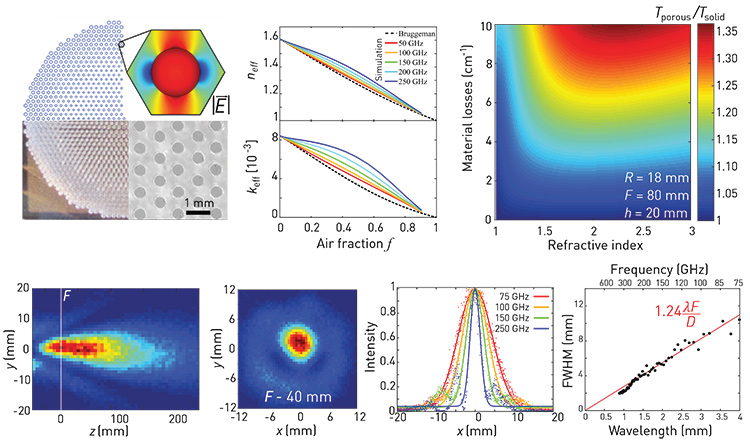 Top left: Design of the porous lens. The electric field is enhanced in the subwavelength holes. Center: Real (neff) and imaginary (keff) parts of complex effective refractive index as a function of the air fraction. Right: Calculated ratio of power transmission between a porous lens (Tporous) and an all-solid lens (Tsolid) for different refractive indices. Bottom left: Longitudinal intensity and focused beam at 150 GHz. Bottom right (graphs): Fitting of the beam waists at various wavelengths showed diffraction-limited behavior.
Top left: Design of the porous lens. The electric field is enhanced in the subwavelength holes. Center: Real (neff) and imaginary (keff) parts of complex effective refractive index as a function of the air fraction. Right: Calculated ratio of power transmission between a porous lens (Tporous) and an all-solid lens (Tsolid) for different refractive indices. Bottom left: Longitudinal intensity and focused beam at 150 GHz. Bottom right (graphs): Fitting of the beam waists at various wavelengths showed diffraction-limited behavior.
Terahertz (THz) radiation has received considerable attention for applications in wireless communications, sensing and imaging.1 Power absorption losses of dielectric materials that are used to fabricate THz components, however, vary quadratically with frequency, so the conventional approach of designing optical components by varying the thickness can be problematic. Another design strategy, gradient index (GRIN) optics, can build versatile and ultrathin beam-forming components—but implementing GRIN optics using metamaterials can lead to high ohmic losses and narrowband operation.2
In work reported this year, we developed low-loss planar porous optical components for the terahertz range.3 Our approach uses low-refractive-index subwavelength inclusions in a solid material to design optical components with smaller losses than their all-solid counterparts, but with otherwise identical optical properties. This is possible because the electric field is enhanced in the subwavelength holes, resulting in a faster decrease of the material’s effective losses relative to changes in its effective refractive index as porosity increases.
We performed a comparative analysis of the losses of a porous lens and an all-solid planoconvex lens. We found that the ratio of the power transmissions through porous and solid lenses (Tporous/Tsolid) was greater than unity, indicating that the porous lens outperformed the all-solid one. A porous lens from a material with a refractive index of 1.6 and losses of 10 cm–1, for example, would show transmission power 25% greater than an all-solid lens with the same material.
We next fabricated a porous lens by laser-engraving subwavelength holes in a PMMA (plexiglass) substrate. The hole size was radially varied to introduce a quadratic dependence of the refractive index. We imaged a THz beam with a THz time-domain system and observed that it was correctly focused at the predicted focal length. Measurements of the focused beam widths at several wavelengths confirmed that it was diffraction-limited.
We believe that this work should interest the broad optical community, since it provides a comprehensive approach to building low-loss components using porous media. Furthermore, it may open new research directions aimed at using high-loss materials with interesting properties (such as high refractive index or high group velocity dispersion) to build novel low-loss components.
Researchers
Hichem Guerboukha, Kathirvel Nallappan, Yang Cao and Maksim Skorobogatiy, Polytechnique Montréal, Montreal, Quebec, Canada
Mohamed Seghilani and José Azaña, Centre Énergie Matériaux et Télécommunications, Institut National de la Recherche Scientifique, Varennes, Quebec, Canada
References
1. H. Guerboukha et al. Adv. Opt. Photon. 10, 843 (2018).
2. H.-T. Chen et al. Nature 444, 597 (2006).
3. H. Guerboukha et al. Adv. Opt. Mater. 7, 1900236 (2019).
